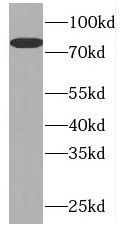Products
PLK2 antibody
Category:
Research Area:
- SPECIFICATIONS
- Product Name
- PLK2 antibody
- Catalogue No.
- FNab06548
- Size
- 100μg
- Form
- liquid
- Purification
- Immunogen affinity purified
- Purity
- ≥95% as determined by SDS-PAGE
- Clonality
- polyclonal
- Isotype
- IgG
- Storage
- PBS with 0.02% sodium azide and 50% glycerol pH 7.3, -20℃ for 12 months(Avoid repeated freeze / thaw cycles.)
Immunogen
- Immunogen
- polo-like kinase 2(Drosophila)
- Alternative Names
- SNK antibody
- UniProt ID
- Q9NYY3
- Observed MW
- 75-80 kDa
Application
- Tested Applications
- ELISA, WB, IP
- Recommended dilution
- WB: 1:500-1:2000; IP: 1:200-1:2000
Validated Images
 HeLa cells were subjected to SDS PAGE followed by western blot with FNab06548(PLK2 antibody) at dilution of 1:2000
HeLa cells were subjected to SDS PAGE followed by western blot with FNab06548(PLK2 antibody) at dilution of 1:2000
 IP Result of anti-PLK2 (IP:FNab06548, 4ug; Detection:FNab06548 1:300) with HeLa cells lysate 2480ug.
IP Result of anti-PLK2 (IP:FNab06548, 4ug; Detection:FNab06548 1:300) with HeLa cells lysate 2480ug.
- Background
- Tumor suppressor serine/threonine-protein kinase involved in synaptic plasticity, centriole duplication and G1/S phase transition. Polo-like kinases act by binding and phosphorylating proteins are that already phosphorylated on a specific motif recognized by the POLO box domains. Phosphorylates CENPJ, NPM1, RAPGEF2, RASGRF1, SNCA, SIPA1L1 and SYNGAP1. Plays a key role in synaptic plasticity and memory by regulating the Ras and Rap protein signaling: required for overactivity-dependent spine remodeling by phosphorylating the Ras activator RASGRF1 and the Rap inhibitor SIPA1L1 leading to their degradation by the proteasome. Conversely, phosphorylates the Rap activator RAPGEF2 and the Ras inhibitor SYNGAP1, promoting their activity. Also regulates synaptic plasticity independently of kinase activity, via its interaction with NSF that disrupts the interaction between NSF and the GRIA2 subunit of AMPARs, leading to a rapid rundown of AMPAR-mediated current that occludes long term depression. Required for procentriole formation and centriole duplication by phosphorylating CENPJ and NPM1, respectively. Its induction by p53/TP53 suggests that it may participate in the mitotic checkpoint following stress.



